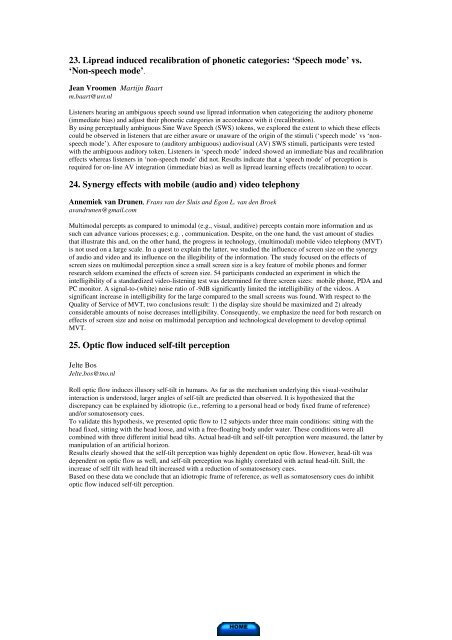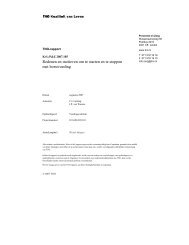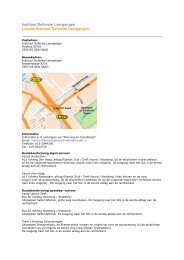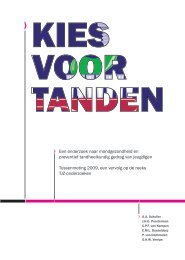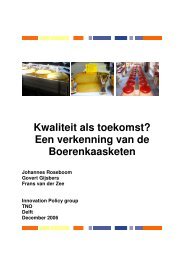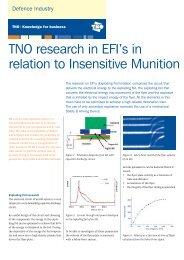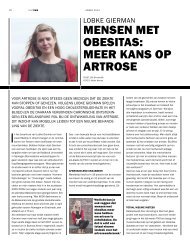Dag van de Perceptie - TNO
Dag van de Perceptie - TNO
Dag van de Perceptie - TNO
Create successful ePaper yourself
Turn your PDF publications into a flip-book with our unique Google optimized e-Paper software.
23. Lipread induced recalibration of phonetic categories: ‘Speech mo<strong>de</strong>’ vs.<br />
‘Non-speech mo<strong>de</strong>’.<br />
Jean Vroomen Martijn Baart<br />
m.baart@uvt.nl<br />
Listeners hearing an ambiguous speech sound use lipread information when categorizing the auditory phoneme<br />
(immediate bias) and adjust their phonetic categories in accordance with it (recalibration).<br />
By using perceptually ambiguous Sine Wave Speech (SWS) tokens, we explored the extent to which these effects<br />
could be observed in listeners that are either aware or unaware of the origin of the stimuli (‘speech mo<strong>de</strong>’ vs ‘nonspeech<br />
mo<strong>de</strong>’). After exposure to (auditory ambiguous) audiovisual (AV) SWS stimuli, participants were tested<br />
with the ambiguous auditory token. Listeners in ‘speech mo<strong>de</strong>’ in<strong>de</strong>ed showed an immediate bias and recalibration<br />
effects whereas listeners in ‘non-speech mo<strong>de</strong>’ did not. Results indicate that a ‘speech mo<strong>de</strong>’ of perception is<br />
required for on-line AV integration (immediate bias) as well as lipread learning effects (recalibration) to occur.<br />
24. Synergy effects with mobile (audio and) vi<strong>de</strong>o telephony<br />
Annemiek <strong>van</strong> Drunen, Frans <strong>van</strong> <strong>de</strong>r Sluis and Egon L. <strong>van</strong> <strong>de</strong>n Broek<br />
a<strong>van</strong>drunen@gmail.com<br />
Multimodal percepts as compared to unimodal (e.g., visual, auditive) percepts contain more information and as<br />
such can ad<strong>van</strong>ce various processes; e.g. , communication. Despite, on the one hand, the vast amount of studies<br />
that illustrate this and, on the other hand, the progress in technology, (multimodal) mobile vi<strong>de</strong>o telephony (MVT)<br />
is not used on a large scale. In a quest to explain the latter, we studied the influence of screen size on the synergy<br />
of audio and vi<strong>de</strong>o and its influence on the illegibility of the information. The study focused on the effects of<br />
screen sizes on multimodal perception since a small screen size is a key feature of mobile phones and former<br />
research seldom examined the effects of screen size. 54 participants conducted an experiment in which the<br />
intelligibility of a standardized vi<strong>de</strong>o-listening test was <strong>de</strong>termined for three screen sizes: mobile phone, PDA and<br />
PC monitor. A signal-to-(white) noise ratio of -9dB significantly limited the intelligibility of the vi<strong>de</strong>os. A<br />
significant increase in intelligibility for the large compared to the small screens was found. With respect to the<br />
Quality of Service of MVT, two conclusions result: 1) the display size should be maximized and 2) already<br />
consi<strong>de</strong>rable amounts of noise <strong>de</strong>creases intelligibility. Consequently, we emphasize the need for both research on<br />
effects of screen size and noise on multimodal perception and technological <strong>de</strong>velopment to <strong>de</strong>velop optimal<br />
MVT.<br />
25. Optic flow induced self-tilt perception<br />
Jelte Bos<br />
Jelte.bos@tno.nl<br />
Roll optic flow induces illusory self-tilt in humans. As far as the mechanism un<strong>de</strong>rlying this visual-vestibular<br />
interaction is un<strong>de</strong>rstood, larger angles of self-tilt are predicted than observed. It is hypothesized that the<br />
discrepancy can be explained by idiotropic (i.e., referring to a personal head or body fixed frame of reference)<br />
and/or somatosensory cues.<br />
To validate this hypothesis, we presented optic flow to 12 subjects un<strong>de</strong>r three main conditions: sitting with the<br />
head fixed, sitting with the head loose, and with a free-floating body un<strong>de</strong>r water. These conditions were all<br />
combined with three different initial head tilts. Actual head-tilt and self-tilt perception were measured, the latter by<br />
manipulation of an artificial horizon.<br />
Results clearly showed that the self-tilt perception was highly <strong>de</strong>pen<strong>de</strong>nt on optic flow. However, head-tilt was<br />
<strong>de</strong>pen<strong>de</strong>nt on optic flow as well, and self-tilt perception was highly correlated with actual head-tilt. Still, the<br />
increase of self tilt with head tilt increased with a reduction of somatosensory cues.<br />
Based on these data we conclu<strong>de</strong> that an idiotropic frame of reference, as well as somatosensory cues do inhibit<br />
optic flow induced self-tilt perception.


